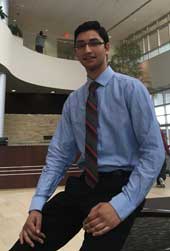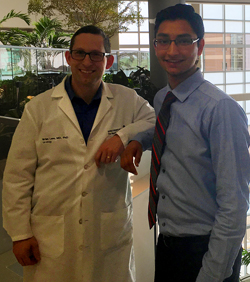Ruchir Gupta became enamored at a young age of tinkering with all things mechanical: elementary school Science Olympiad, building bottle rockets and a mousetrap-powered toy car in middle school helped shape his early decision to steer toward a career in mechanical, then biomedical engineering.
His involvement in a bonafide medical research project made him realize he enjoyed how all that math and science can impact real lives.
The summer before he was to enter middle school, Ruchir recalled, he read about high school students taking part in high-level research projects. He learned about a Grand Valley State University computer engineering professor, Dr. Robert Bossemeyer, who often works with and connects college students to research efforts.
Ruchir wondered, would Bossemeyer consider taking on a (not quite) high school student?

Mature for His Age
Bossemeyer said it is “quite unusual” for him to be contacted by a high school student. The only other one he has worked with at that level also was from the Forest Hills district.
“Our dean does encourage us to spend time in outreach with high school students who have an interest in engineering,” he said. “In getting to know (Ruchir), I figured he was pretty mature for his age and could contribute to our research.”
Bossemeyer also knew about Forest Hills Public Schools’ scientific research program, which started in 2013, and aims to give students a three-year mentored experience participating in authentic research outside school. As part of the program, students report on their research and submit the experience to national science competitions.
Bossemeyer connected Ruchir with Dr. Brian Lane, a urologist at the Lemmen-Holton Cancer Pavilion in downtown Grand Rapids.
Lane and his colleagues were stumped by complications — mainly temporary urinary leakage — experienced by some cancer patients who had undergone partial nephrectomies, a surgery to remove kidney tumors.
Were the biodegradable sutures failing before the body had a chance to heal, they wondered? Could they try different types of sutures? A number of experiments failed to identify sutures as the culprit.
Ruchir spent the first year-and-a-half helping to develop a new experiment, one that would test the clips that are supposed to hold the sutures in place. He helped design and build an apparatus to hold 40 spring-balance mechanisms that simulate the sutures being held taut by the clips, which he attached to hooks he made using a 3-D printer. The mechanisms then were placed into an aquarium filled with saline solution.
The finishing touch: a web camera that snaps a photo every 15 minutes, so the research team could see which clips failed and when. The result: in about two minutes, some clips began starting to migrate before sliding completely off, Ruchir said.
Now, instead of using the clips, Dr. Lane and his colleagues are simply tying the ends of the sutures in knots, with a lot less complications for patients.
“It’s more reliable until they develop a better clip,” Ruchir said.
Added Lane: “I’m calling it ‘the Ruchir technique’ in the operating room.”

Future Course Adjustment
In an independent research class led by teacher Kristy Butler, Ruchir wrote a paper detailing the experiment, which was reviewed by Dr. Lane and submitted to the esteemed Journal of Urology. Once the pair does a handful of more experiments, he said, their article is on its way to being published.
Ruchir, who is headed to Washington Jefferson College in Pittsburgh in the fall, then on to Temple Medical School, called it “a cool project.”
Dr. Lane, who could only recall ever working with one other high school student on a research project, had more to say about his young charge.
“I think his quality of work is comparable to the residents I work with,” Lane said. “What I have been most impressed by has been his initiative, his follow-through and that he works well with others with the appropriate level of respect.”
As for Ruchir, the project helped him adjust the course for his future: medical school and maybe a career in pediatrics.
“I liked how applicable the research was to what patients were actually dealing with,” he said. “That’s really what got me interested.”
CONNECT
Grand Valley State University’s Biomedical Engineering Program









